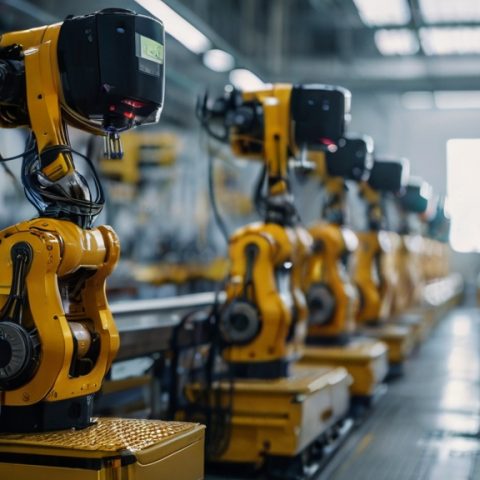Welcome back, my fellow data labeling and machine learning friends! Today, I wanted to delve into robotics and manufacturing and understand the crucial role of data in honing the precision and efficiency of automated systems. I’m here to guide you through the essentials of robotics data annotation, sharing insights and best practices that can transform your approach to automation. Let’s explore how proper data annotation isn’t just a task; it’s a cornerstone of success in our machine learning and AI-driven world.
Understanding the Importance of Data Annotation in Robotics
Data annotation in robotics is as crucial as training an athlete, preparing them not just for any competition but for the Olympics of their sport. Just like an athlete needs to understand the nuances of the game, a robot must be adept at comprehending its tasks and the environment in which it operates. This is where training data and data annotation step in—they shape how effectively a robot can perform its tasks, from the simple to the complex.
Let’s say you’re programming a robot to assemble car parts. Each part must be recognized and handled precisely, whether placing a dashboard into a car or attaching a wheel. Similarly, in a distribution center, a robot tasked with training data to sort packages must be able to distinguish among various sizes, weights, and destinations. The quality of your robotics data annotation directly influences the robot’s ability to carry out these tasks with high accuracy. If the data tells the robot exactly what a package or a car part looks like under different conditions, the robot can make correct decisions quickly and reliably.
But why is such precision so crucial? In manufacturing and many industrial applications, the margin for error is minimal. A small mistake in understanding a part could lead to production faults, increased waste, and costly delays. Moreover, in high-speed automation environments, these robots must make split-second decisions based on the data they receive. The better the training data (via high-quality annotation), the better these robots can perform without errors.
Data annotation does more than label objects in the robot’s world; it also involves teaching the robot to interact dynamically with its environment. For instance, a robot might need to adjust its grip on a slippery surface if previous data annotations have included information about various surface textures and grip techniques. This kind of detailed annotation and generative AI can dramatically enhance a robot’s adaptability and functionality.
Ultimately, the stakes are high, and the demands for precision are even higher. Whether it’s a matter of safety, efficiency, or cost, ensuring your robotic systems understand their environment through meticulously annotated data is not just beneficial—it’s essential. By investing in quality data annotation, you’re equipping your robots to meet the challenges of modern manufacturing with the expertise and accuracy required. This is how data annotation becomes not just a task but a pivotal element in the success of robotics in any tech-driven industry.
The Basics of Data Annotation: What You Need to Know
Data annotation involves labelling data , like images or videos, to make it understandable for machines. For instance, by annotating images of components on a production line, you help robotic systems recognize these items in real-world operations. This might sound straightforward, but the devil is in the details. Each piece of annotated data must be accurate, consistent, and as close to real-world scenarios as possible.
Best Practices in Data Annotation for Robotics
It is crucial to start with a solid foundation in robotics data annotation. Here, I’ll walk you through the best practices that ensure your robotic systems operate with peak efficiency and precision.
- Start with Quality Data: The adage “garbage in, garbage out” holds particularly true here. Ensure your data accurately represents the tasks and environments your robots will encounter.
- Use the Right Tools: Leverage advanced annotation tools that offer precision and flexibility. Tools that support automation and AI-assisted tagging can significantly speed up the process while enhancing accuracy.
- Consistency is Key: To maintain consistency, standardize the data labeling and annotation process across your team. This might mean developing detailed guidelines that every annotator follows.
- Iterative Review and Refinement: Regularly review and refine the annotated data. This iterative process helps catch errors and adjust annotations to meet your robotic systems’ needs better.
Overcoming Common Challenges in Data Annotation
Data annotation for Robotics presents several challenges that can impede the efficiency and effectiveness of automated systems. From handling complex scenes in busy manufacturing environments to dealing with ambiguous scenarios where clear-cut answers are scarce, each challenge demands a tailored approach. Additionally, as the scale of robotic operations grows, the volume of data needing annotation and data labeling expands, making scalability a crucial consideration. Here, I’ll discuss a little more on how to navigate these common hurdles to keep your data annotation efforts on track and effective.
- Handling Complex Scenes: In a manufacturing setting, robots might face complex and overlapping objects. Developing strategies for layering annotations can help tackle this challenge.
- Dealing with Ambiguity: Sometimes, what you’re annotating isn’t clear-cut. Establishing clear rules for ambiguous cases is crucial for maintaining high-quality data.
- Scalability: As your robotic applications scale, so does the need for annotated data. Planning for scalability from the outset can save you significant time and resources.
Real-World Success Stories
Now, let’s examine some compelling case studies where practical data annotation has catalyzed significant advancements in robotics. These demonstrate the tangible impacts of meticulous data practices in diverse industries.
First, consider the case of a leading autonomous vehicle manufacturer. This company revamped its robotic assembly line by implementing refined data annotation techniques, which involved labelling thousands of car parts images using image annotation for machine learning models. The improved annotation accuracy allowed robots to identify and assemble parts more precisely. The result was a remarkable 20% increase in production speed and a 30% decrease in manufacturing errors, dramatically enhancing overall efficiency and reducing costly production downtime.
Another example comes from the world of e-commerce fulfillment. A major online retailer employed advanced data annotation to train their sorting and packaging robots. These robots could adapt to varying sizes, weights, and fragility indicators by annotating a wide range of product types and packaging scenarios and optimizing the packaging process. Implementing these detailed annotations led to a 40% improvement in packing speed while also decreasing the rate of product damage during shipping by half, ensuring customer satisfaction and reducing returns.
In agriculture , data annotation is transforming traditional farming methods. A startup specializing in agricultural robotics used object detection, object recognition, data annotation, video annotation and image annotation to develop drones and ground robots capable of identifying unhealthy plants. By annotating images of plant leaves with signs of disease or pest infestation, these AI models and robots could detect and treat affected areas early, significantly increasing crop yields. This precise image annotation intervention reduced pesticide use by 25% and improved crop health across monitored fields, showcasing precision agriculture’s environmental and economic benefits.
Lastly, robotics enhanced with data annotation in the healthcare industry makes surgeries safer and more precise. A medical device company developed a robotic system that assists surgeons by providing augmented reality overlays during procedures. These robots offer real-time guidance by annotating medical imaging data to highlight anatomical landmarks and potential risk areas, improving surgical outcomes. This has led to shorter recovery times for patients and has minimized the risks of surgical complications. A great example of AI and data annotation real-world use cases in healthcare can be found in our most recent client case study with SURGAR , a leading medical device startup using augmented reality and artificial intelligence to assist with mini-invasive surgery.
These are just a few case studies that illustrate how effective data annotation is not merely a technical process but a strategic investment that can lead to breakthroughs across various sectors. By ensuring high-quality data annotation, companies can unlock the full potential of robotic automation, leading to improved efficiency, reduced costs, and enhanced accuracy in their operations.
Looking Ahead: The Future of Data Annotation in Robotics
As AI continues to evolve, the future of data annotation looks promising and exciting, to say the least. With the advent of more sophisticated AI models, the extent of manual annotation needed will likely decrease, making way for more semi-automated processes like SmartOne AI’s data annotation service and text annotation services. This evolution will allow us to focus more on strategy and less on the minutiae of an artificial intelligence model and its annotation.
As a service provider for data annotation in robotics and manufacturing, we know it’s no small feat. However, we also know it’s undeniably rewarding. As we’ve discussed, it’s not just about labelling data; it’s about crafting a foundation that allows robots to perceive and interact with their world effectively.
I hope this guide has shed some light on the topic and hopefully sparked ideas on enhancing your robotic systems. Remember, in the age of automation, data isn’t just king—it can be the ace up your sleeve.










